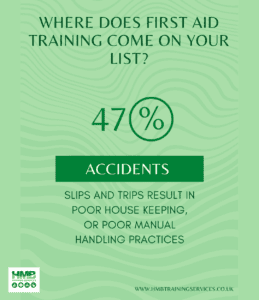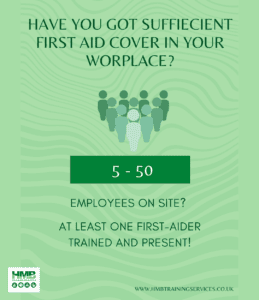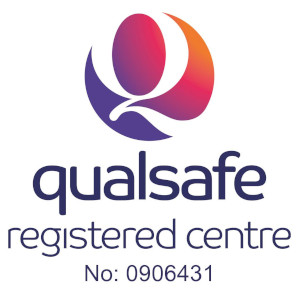Are you looking for First Aid at Work Courses ‘near me’? At HMB Training Services we can help you with your first aid at Work training for your staff at your workplace.
In this blog, we can help you with the legal aspect of having the correct first aiders on site, how to have a safer workplace, the importance of first aid training in the workplace, and what can happen if you haven’t got a sufficient amount of first aiders in your workplace.
Statistics – what you need to know
Reports have highlighted cases where first aid interventions were crucial in preventing further harm or complications following workplace incidents. This underscores the importance of having trained first aiders in various work environments.
Here are the latest statistics From HSE;
- 1.8 million working people suffering from a work-related illness, of which

- 914,000 workers suffering from work-related stress, depression, or anxiety
- 477,000 workers suffering from a work-related musculoskeletal disorder
- 123,000 workers suffering from COVID-19 which they believe may have been from exposure to coronavirus at work
- 2,268 mesothelioma deaths due to past asbestos exposures (2021)
- 135 workers killed in work-related accidents (2022/23)
- 565,000 working people sustained an injury at work according to the Labour Force Survey
- 61,713 injuries to employees reported under RIDDOR
- 36.8 million working days lost due to work-related illness and workplace injury
- £18.8 billion estimated cost of injuries and ill health from current working conditions (2019/20)
Having sufficient first aiders on site will reduce these statistics. Receiving first aid at work courses ‘near me’, will help identify risks and hazards to staff to reduce accidents, and staff will know how to act quickly when a first aid accident happens.
The Importance of First Aiders in the Workplace
Having a team of first aid trained staff in the workplace is of paramount importance, as it serves as a frontline defence against unforeseen emergencies. These individuals are equipped with the skills and knowledge to provide immediate and effective assistance in the critical moments following an accident or illness.
emergencies. These individuals are equipped with the skills and knowledge to provide immediate and effective assistance in the critical moments following an accident or illness.
The ability to administer prompt first aid can make a crucial difference in preventing the escalation of injuries, reducing recovery time, and even saving lives. Beyond the immediate impact on the well-being of employees, first aid trained staff contribute to a culture of safety within the workplace. Their presence instils confidence among colleagues, fostering a sense of security and preparedness.
Additionally, first aid training goes hand-in-hand with legal compliance, ensuring that employers meet regulatory standards for providing a safe working environment. In essence, the significance of having first aid trained staff lies not only in their capacity to respond swiftly to emergencies but also in their role as catalysts for a safer, more resilient, and proactive workplace culture.
Immediate Response to Emergencies
“Immediate Response to Emergencies” is a critical aspect of first aid at work that focuses on equipping individuals with the necessary skills and knowledge to respond swiftly and effectively to emergencies in the workplace. Here are additional insights into why immediate response is so vital:
Time-Critical Situations:
In many emergency situations, time is of the essence. Immediate response can make a significant difference in outcomes, especially in cases of cardiac arrest, severe bleeding, or respiratory distress. First aid training provides individuals with the ability to assess situations rapidly and take prompt action.
Preventing Further Harm:
A key goal of immediate response is to prevent the escalation of injuries or illnesses. Well-trained first aiders can take immediate steps to stabilise a person’s condition, reduce pain, and prevent complications. This proactive approach contributes to the overall well-being and recovery of the affected individual.
Maintaining Vital Functions:
Certain emergencies, such as heart attacks or choking, can lead to the impairment of vital bodily functions. First aid training teaches first aiders how to initiate cardiopulmonary resuscitation (CPR), clear airways, and perform other critical interventions to maintain essential bodily functions until professional medical help arrives.
Minimising Response Time:
Immediate response skills empower individuals to quickly assess a situation, prioritise actions, and provide aid promptly. This can minimise the overall response time, improving the chances of a positive outcome for the person in distress.
Enhancing Safety in the Workplace:
The ability to respond immediately to emergencies enhances overall workplace safety. Knowing that there are trained individuals on-site who can take swift action in the event of an incident provides a sense of security for both employees and employers.
Boosting Confidence and Calmness:
First aid training not only imparts practical skills but also instils confidence in individuals to handle emergency situations. Trained responders are more likely to remain calm under pressure, enabling them to provide effective assistance without unnecessary panic.
Supporting Professional Medical Services:
Immediate response is not a substitute for professional medical care but serves as a crucial bridge until such help arrives. First aiders are trained to communicate effectively with emergency services, providing valuable information that aids in the rapid and appropriate deployment of professional medical assistance.
Creating a Culture of Safety:
An emphasis on immediate response fosters a culture of safety within the workplace. It encourages a collective responsibility for the well-being of colleagues and reinforces the importance of preparedness for unforeseen events.
Having immediate response to emergencies is a cornerstone of first aid training, offering the potential to save lives, minimise the impact of injuries, and create a safer and more resilient working environment.
legal aspect of having the correct first aiders on site
The legal aspect of having the correct first aiders on site is a crucial dimension of workplace safety and compliance. In many jurisdictions, specific regulations mandate that employers provide adequate first aid provisions in the workplace.
These regulations often necessitate a thorough first aid needs assessment to determine the appropriate number of first aiders and the level of training required based on the nature of the work and the potential risks involved. Failing to have the correct number of properly trained first aiders on site can result in legal consequences.
Employers are legally obligated to ensure the health, safety, and well-being of their employees, and providing sufficient first aid support is an integral part of fulfilling this duty of care. Compliance with first aid regulations not only mitigates legal risks but also contributes to a safer work environment, reduces the severity of injuries, and demonstrates a commitment to the welfare of employees.
Regular reviews, updates, and refresher training for first aiders are essential to maintaining legal compliance and ensuring that first aid provisions remain effective in response to evolving workplace conditions.
How Many First Aiders?
Knowing how many first aiders you need for your workplace, you will need to answer these questions:
 ~ From your risk assessment, what degree of hazard is associated with your work activities?
~ From your risk assessment, what degree of hazard is associated with your work activities?
~ How many employees do you have?
Low-hazard, eg offices, shops, libraries
Fewer than 25 employees = At least one appointed person
25–50 employees = At least one first-aider trained in EFAW
More than 50 employees = At least one first-aider trained in FAW for every 100 employed (or part thereof)
Higher-hazard, eg light engineering and assembly work, food processing, warehousing, extensive work with dangerous machinery or sharp instruments, construction, chemical manufacture
Fewer than 5 employees = At least one appointed person
5–50 employees = At least one first-aider trained in EFAW or FAW depending on the type of injuries that might occur
More than 50 employees = At least one first-aider trained in FAW for every 50 employed (or part thereof)
What are the fines?
Failure to comply with the legal requirements for first aid at work, as outlined in the Health and Safety (First Aid) Regulations 1981, can result in various penalties and consequences for employers. The penalties aim to encourage compliance and ensure the safety and well-being of employees. The specific penalties may include:
Improvement Notice:
If a Health and Safety Executive (HSE) inspector finds that an employer is not meeting the required first aid standards, they may issue an improvement notice. This notice outlines the specific improvements that must be made within a specified timeframe.
Prohibition Notice:
In cases where there is a serious and imminent risk to health and safety, an inspector may issue a prohibition notice. This notice prohibits certain activities or requires specific actions to address the identified risks. Failure to comply with a prohibition notice is a criminal offense.
Prosecution:
Employers who consistently fail to comply with the first aid regulations may face prosecution. Legal action can result in fines imposed by a court. The severity of the fine will depend on the nature and extent of the breaches.
Criminal Offense:
Failure to comply with the Health and Safety (First Aid) Regulations 1981 is considered a criminal offense. Convictions can lead to fines and, in some cases, imprisonment for individuals found responsible for the breaches.
Liability for Damages:
If an employer’s failure to provide adequate first aid results in harm to an employee, the employer may be held liable for damages. This can involve compensation claims and legal costs.
Reputation Damage:
Non-compliance with health and safety regulations, including those related to first aid, can damage the reputation of a business. This can have long-term consequences, affecting relationships with clients, customers, and employees.
Closure of the Workplace:
In extreme cases where there is a severe and persistent disregard for health and safety regulations, authorities may take steps to close down the workplace until compliance is achieved.
An example of a fine where a worker seriously injured his hand while using a machine with rotating blades. Due to the machine stopping several times that morning the worker presumed the machine was fixed as an engineer was called out. When a fault arose again, rather than stopping the machine, the worker tried to unblock the blockage by putting his hand into the base of the cabinet.
While doing so his hand came into contact with a rotating bandsaw blade.
Failings of sufficient measures were in place to stop the blade from rotating when the cabinet housing was open.
Company fined £60k plus £20k in costs.
How to have a safer workplace
Creating a safer workplace involves a comprehensive approach that addresses various aspects of health, safety, and well-being. Here are key steps to promote a safer work environment:
Conduct a Risk Assessment:
Regularly assess workplace hazards and risks. Identify potential sources of accidents, injuries, and health issues. This evaluation forms the basis for implementing targeted safety measures.
Implement Health and Safety Policies:
Develop and communicate clear health and safety policies. Ensure that all employees are aware of these policies and understand their role in maintaining a safe workplace.
Provide Adequate Training:
Ensure that employees receive proper training on safety procedures, equipment usage, and emergency response. This includes first aid training, fire safety drills, and training on specific workplace hazards.
Promote a Safety Culture:
Foster a culture of safety where employees feel empowered to report hazards and near-misses without fear of reprisal. Encourage open communication and regular safety discussions.
Maintain Clean and Organised Workspaces:
Clutter and disorganisation can contribute to accidents. Encourage employees to keep their workspaces tidy, and implement regular cleaning schedules to prevent slips, trips, and falls.
Provide Personal Protective Equipment (PPE):
Identify the appropriate PPE for different job roles and ensure that employees use it correctly. This may include safety glasses, gloves, helmets, or other specialised equipment.
Regular Equipment Maintenance:
Regularly inspect and maintain machinery, tools, and equipment to ensure they are in good working condition. Malfunctioning equipment can pose serious safety risks.
Encourage Regular Breaks:
Fatigue can contribute to accidents and decreased concentration. Encourage employees to take regular breaks to rest and recharge, especially in roles that involve repetitive tasks.
Emergency Preparedness:
Establish and communicate emergency procedures, including evacuation plans and assembly points. Conduct regular drills to ensure that employees are familiar with these procedures.
Access to First Aid:
Ensure that first aid supplies are readily available and that there are trained first aiders on site. This is essential for providing immediate assistance in case of injuries or medical emergencies.
Address Mental Health:
Recognise the importance of mental health in the workplace. Promote a supportive environment, provide access to resources, and destigmatise conversations about mental health.
Regular Safety Audits:
Conduct regular safety audits to identify potential hazards and assess the effectiveness of safety measures. Use these audits to continuously improve safety protocols.
Encourage Reporting:
Establish a system for reporting safety concerns or incidents. Investigate reports promptly and take corrective actions to prevent similar incidents in the future.
Stay Informed about Regulations:
Keep abreast of health and safety regulations relevant to your industry. Ensure that your workplace practices comply with these regulations to avoid legal repercussions.
By taking a proactive and holistic approach to safety, employers can significantly reduce the risk of accidents and injuries in the workplace, creating a safer and healthier environment for all employees.
What can happen if you haven’t got the sufficient amount of first aiders in your workplace?
First Aid at Work Courses Near Me
All of our courses are tailored for the group of learners in a fun and friendly way. We consider your start and end times to adapt to your staff schedule. We can add any specifics from your polices, systems of work or previous accidents and risk assessments amendments. On our courses we can add any extra modules or certain previous accidents or near misses. The first aid courses can be adapted to include an element of health and safety. You are really getting a lot for your money and time taking courses with HMB Training Services. Lets teach you what you need to know before giving CPR.
Emergency first aid at work courses near me;
The Emergency First Aid at Work course is a vital training designed to equip individuals with the necessary skills to handle emergency situations in the workplace. This course provides participants with the knowledge and confidence to effectively respond to injuries, illnesses, and accidents that may occur on-site. Covering topics such as assessing and managing incidents, CPR, choking, bleeding control, and more. The Emergency First Aid at Work course ensures that attendees are prepared to provide immediate and appropriate assistance until professional medical help arrives. This comprehensive training is essential for creating a safe and prepared work environment, where employees can confidently handle emergencies and potentially save lives.
First Aid at Work;
The first aid at work courses near me are a comprehensive training course designed to provide individuals with the knowledge and skills necessary to effectively respond to a wide range of medical emergencies in the workplace. This course goes beyond basic first aid training and covers topics such as assessing and managing incidents, CPR and AED usage, treating various injuries and illnesses, dealing with trauma, and more. Participants will learn how to handle emergency situations calmly and efficiently, ensuring the well-being of their colleagues and reducing the risk of further harm. The First Aid at Work course is essential for designated workplace first aiders, supervisors, and anyone responsible for the health and safety of employees. By completing this course, individuals can play a crucial role in promoting a safe and prepared work environment, where prompt and effective first aid can make a significant difference in saving lives and minimising the impact of injuries or illnesses.
Why is it vital to know how to administer First Aid Courses in West Midlands?
- Reduce accidents and injuries in your workplace
- Quick reaction and speed in administrating first aid will help save lives
- Reduce the number of incidents by sufficient trained first aiders
- Become more confident and knowledgeable in treating someone
- Increases safety within the workplace; having first aid training promotes a sense of safety and well-being
- Reduce the cost to the employer; reduce staff absences and fines from HSE
- First aid Training is a form of team-building activity
Why book your Training with HMB Training Services Ltd
How can HMB Training Services help you? HMB Training Services was created in August 2016 by founder and director Heather Marie Bird. Heather has worked at large companies such as Cat Finning and A-Plant as well as smaller companies and schools.
HMB Training Services can help you with the following:
- Emergency First Aid
- First Aid at Work
- Re-qualifying First Aid
- Annual First Aid refreshers
- Health & Safety
- Manual Handling
- Fire Awareness
- Fire Marshall
- Mental Health First Aid
We can help manage your certifications by reminding you when renewals become due so that you don’t have to keep track of everyone’s individual renewal dates.
We can offer times to suit your business needs and can visit your company to train groups of four or more people. Our training sessions are adaptive to the audience and we can arrange to include any additional modules that may be considered relevant for your particular business.
If you are looking for first aid at work courses near me we can help.
Read more blogs here: https://www.hmbtrainingservices.co.uk/latest-news
Additionally, please do call us on 01543 453338 to see how we can help with delivering group training courses.



